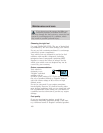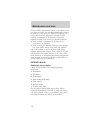
ESSENTIALS OF GOOD FUEL ECONOMY
Measuring techniques
Your best source of information about actual fuel
economy is you, the driver. You must gather
information as accurately and consistently as
possible. Fuel expense, frequency of fillups or fuel
gauge readings are NOT accurate as a measure of
fuel economy. We do not recommend taking fuel
economy measurements during the first 1 600 km
(1 000 miles) of driving (engine break-in period).
You will get a more accurate measurement after
3 000 km–5 000 km (2 000 miles-3 000 miles).
Filling the tank
The advertised fuel capacity of the fuel tank on your
vehicle is equal to the rated refill capacity of the fuel
tank as listed in the Refill Capacities chart in this
“Owner Guide.” The advertised capacity is the
amount of the Indicated Capacity and the Empty
Reserve combined. Indicated Capacity is the
difference in the amount of fuel in a full tank and a
tank when the fuel gauge indicates empty. Empty
Reserve is the small amount of usable fuel remaining
in the fuel tank after the fuel gauge indicates empty.
The amount of Empty Reserve varies and
should not be relied upon to increase driving
range. When refueling your vehicle after the
fuel gauge indicates empty, you might not be
able to refuel the full amount of the advertised
capacity of the fuel tank due to the empty
reserve still present in the tank.
For consistent results when filling the fuel tank:
• Use the same filling rate setting (low — medium
— high) each time the tank is filled.
• Allow three automatic click-offs when filling.
• Always use fuel with the recommended octane
rating.
Maintenance and care
164


















